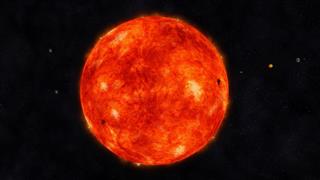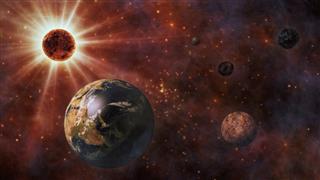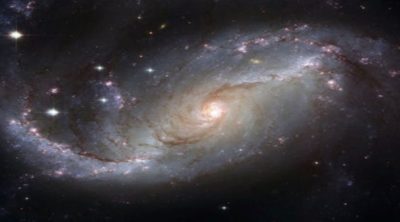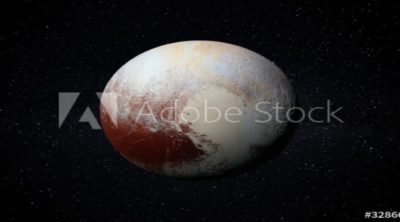
How exactly was the Sun formed? How was our beloved star born? If you want an answer to these questions, reading this article will be an illuminating experience. The process of formation of the Sun is the first of a series of events, that eventually made life possible on Earth. Read on, to know how this great ball of fire was ignited.
Sun is the central pivot around which our whole world, our solar system, is built. Since time immemorial, right from the dawn of human civilization, the Sun has been rightly worshiped as a source of energy, life, and hope. There is no sight comparable to the beauty of a red sun, rising at dawn, in all its glory.
The sight of the rising Sun invokes a primitive reverence and curiosity from inside us, as to how this glorious ball of fire was ever created. We cannot help but feel inwardly connected to this brilliant portal of light and energy.
How was our parent star formed? Has it been there forever, shining down on us? What is the source of its limitless energy? This article endeavors to answer these questions and put forth whatever is discovered in the field of astronomy about the Sun, through centuries of painstaking research and observation.

Basics of Stellar Physics
If you ask me how the universe was created, I may not be able to answer completely, but I can confidently tell you, how the Sun formed. The answer to it has been pretty much figured out after years of investigation. The answer to this question will take us deep into the realm of stellar physics, that is the physics of stellar evolution. To understand how the Sun was created from interstellar gas, you must know some fundamental ideas of stellar evolution, which are as follows.
Life of a Star: Tussle Between Gravity and Thermal Pressure
Sun is basically a star. It is just like all those ‘little diamonds in the sky’, you see at night, except that this one’s really close. Gravity is always at work, as it sculpts the structure of the universe like galaxies and stars.
A star is a gargantuan ball of plasma (This is a gas, made of charged ions), mostly made up of Hydrogen and Helium. The life of a star is a constant tussle between gravitational pressure that tries to crush this ball of gas, versus thermal pressure generated through nuclear fusion.
Consider an inflated balloon. A balloon stays inflated, due to the balance between external air pressure which tries to crush it and internal air pressure which keeps it inflated. Similarly, a star is stable when thermal pressure, generated by nuclear fusion, is balanced with the gravitational force that tries to crush it. When this balance is disturbed, a star changes its form.
Stars are Natural Fusion Reactors
To heat a gas and create thermal pressure, a star needs energy. Where does it come from? This problem was solved by Hans Bethe and his associates. The terrific amount of energy that powers a star is generated through nuclear fusion. It is a process by which lighter nuclei like Hydrogen fuse together to form heavier elements, under temperatures in excess of 7 million Kelvin. The mass of the fused nuclei is less than the combined mass of fusing nuclei. That is, some mass is lost in the process of fusion and converted into pure energy. This energy can be calculated by using the well-known, celebrated formula of Albert Einstein, ‘E = mc2‘. This process turns the stars into natural fusion reactors. They are natural furnaces of the universe, where heavy elements like Carbon and Nitrogen are synthesized.
The More Massive they are, Quicker they Die
The initial mass of a star, is the most important factor which decides its future evolution. In the illustration below, you can see the different fates of stars with different initial masses.

This graphic summarizes how stars evolve according to their initial mass with time(Credit: NASA/CXC/M.Weiss)
As you can see in the image above, there is a simple relation between mass and age, that helps you determine how long a star will last. Stellar evolution theory is developed enough to predict the lifetime of a star, given its initial mass. The more massive a star is, the more it will be squeezed and crunched by gravity. As a star is crunched by gravity, it gets hotter and its core temperature rises. As core temperature rises, the hydrogen fuel in its core will be fused faster. This is just like a high power sports motorbike which uses up fuel, very fast. So, to sum it all up, more massive a star is, the sooner will it exhaust its fusion fuel and die.
How was the Sun Created?
Now that you (hopefully) have some idea about what happens inside a star, let us how our dear old star came to be.
Stage 1: Interstellar Gas Collapses Under Gravity
All great structures ever created in the Universe are modeled by gravity. About 6 billion years ago, a huge ultra cold Hydrogen cloud, which contained remnants of dead stars from the past, started collapsing under gravity. The remnants of previous stars were contained in this gas cloud, in the form of heavy elements that were synthesized in the stars, which could be called Sun’s predecessors. Universe keeps on recycling stuff, all the time.
So, this cloud of gas and interstellar dust started collapsing under gravity. This collapse may have been triggered by a nearby supernova explosion or some other event with a high energy output. As this heavy element rich gas started collapsing, its gravitational potential energy got converted into thermal energy and the gas got heated up.
Stage 2: Protostar is Created
As the gas collapsed over time, it became denser and hotter. Over time, a spherical inner core started forming, which was hotter than rest of the star. This was the baby sun, or the protostar, as it’s called. This protostar was not yet hot enough, for the hydrogen in its core to start fusing. However, thermal pressure generated by gravitational collapse had started exerting itself against gravity. If the mass of this early Sun had been little less than what it was, the gravitational collapse would have halted there itself, balanced by thermal pressure. That would have been the end of our Sun, staying just short of being a star. Many protostars undergo such a stellar ‘still-birth’ of sorts, never reaching the status of a star.
However, fortunately, the Sun was massive enough for the gravitational collapse to continue. This compression of the protostellar gas blob caused a continuous increase in the temperature.
Stage 3 : Hydrogen Fusion Starts
At some point, as temperature of the proto-Sun crossed the barrier of 7 million Kelvins, and hydrogen nuclei, which till now were bouncing off each other, started fusing into Helium. This was the ignition of Sun’s fusion furnace, which is the source of its phenomenal energy output.
This is the point where the protostar, became a star and thermal pressure generated by nuclear fusion, effectively neutralized the gravitational pressure, reaching hydrostatic equilibrium. This phase in a star’s life is called the ‘Main Sequence’, and a star spends a major part of its life in this phase. Since that point of time, Sun has been fusing its Hydrogen fuel into Helium, at a steady pace, for 4.5 billion years. It will continue in this state for millions of years to come.
So this is how our Sun was created from the ashes of a previous star. This early Sun had a disk of swirling matter around it, which eventually condensed into our solar system, as we know it.
Fate of the Sun
What happens, when the Hydrogen fuel in the core runs out? What is the future of our beloved star?
Thankfully, the theory of stellar evolution has developed enough to answer this question too. One day, thousands of millions of years into the future, when Hydrogen in the solar core is exhausted, it will be the beginning of the end of the Sun, and our solar system, as we know it.

As the nuclear fusion, stalling gravitational collapse, will cease, the solar core will start collapsing and heating up again. As the core is compressed and crunched again by gravity, outer layers of Sun will start expanding out. The surface temperature of our Sun will drop as it expands in size, turning into a ‘Red Giant’ like the star ‘Betelgeuse’ in Orion constellation.
As the Sun expands, it will swallow, Mercury and Venus. The temperature on Earth will increase drastically. By then, mankind (if it has managed not to self-destruct itself.) will have to find an abode other than Earth, on exterior or even extrasolar planets. The orbit of the planets as we know them will be changed too.
The core of this red giant Sun will keep on compressing, until it becomes hot enough to fuse Helium into Carbon. Then millions of years in the future, the helium fuel in the core will also be spent. As the core collapses again under gravity, it will never heat up enough to fuse any more heavier elements. The gravitational collapse will be halted by something known as ‘Electron degeneracy’. According to one of the fundamental principles of quantum physics (called Pauli exclusion principle), electrons cannot be compressed beyond a point, as all of them cannot have the same quantum state.
So, as the electrons cannot be compressed beyond a point, gravitational compression halts, outer envelopes of the Sun will be ejected and the core will remain as a white dwarf. Its energy will be slowly radiated over eternity and it will die a cold death.
This is the predicted fate of our beloved star. The universe is like clay in the hands of a child who constantly molds new things out of it and destroys them at his own whim.
Will the end of the Sun, be the end of our civilization? I do not think so. Despite insurmountable odds, life was conceived on our planet. We will survive, if our future generations are smarter than us and find a way to achieve peace on Earth. Hopefully, they will find a way out of this and humanity will no longer be confined to a little blue dot in space but spread elsewhere, finding new habitats in the galaxy.





